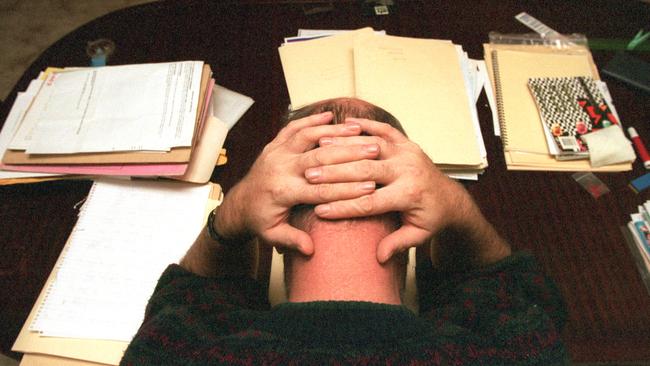Nearly 75 per cent of Aussie workers say they feel unable to take annual leave
Cost of living pressures and ‘a pile of work’ are driving an unhealthy example in Aussie workplaces with concerning consequences.
National
Don't miss out on the headlines from National. Followed categories will be added to My News.
Three quarters of Australians will likely be stuck at work this Christmas as staff shortages and rising living costs prevent them taking a break.
New research from ELMO Software reveals 75 per cent of workers feel unable to take annual leave, with two in five saying they need to stay at work to save money due to increased living costs.
A quarter say they have too much work to take leave.
ELMO chief executive officer Danny Lessem says the decision not to take annual leave entitlements could be disastrous.
“If up to 75 per cent of workers won’t take their Christmas leave, or they truncate it, then we are definitely going to have an increase in mental health issues and burn out pretty early next year,’’ he says.
JUST DO IT
Health experts have long argued that taking regular breaks from work has significant mental and physical health benefits, with some research going so far as to say taking annual leave can reduce the risk of premature death.
Lessem encourages Australians to ignore calls from their bosses to stay at work and instead urges them to prioritise time off.

“There will be pressure from employers (not to take annual leave) but … our labour laws are pretty clear – people are entitled to take their 20 days leave a year,’’ he says.
“We’re already feeling stressed over increasing living costs but if you’re not taking your leave then there’s the stress of being burnt out in the workplace as well and that’s a lethal concoction in terms of people’s mental health profile.’’
STAYCATION
For those that can’t afford to go away, Lessem says a staycation at home is a viable alternative.
“I know the concept of the staycation is probably a bit stale after three years of Covid but I would suggest having a break from the workplace would be more beneficial than not having a break at all,’’ he says.
“You can’t have this torrent of work and be constantly trying to get over the mountain but the mountain just gets bigger and bigger.
“Staying at home is better than nothing. And maybe it suits the cricket aficionados (who can watch televised games over summer).”
RESET AND RECHARGE
Credit Union SA chief member and experience officer Karen Beard knows the guilt that comes with taking leave at busy work times, having recently returned from a fortnight’s holiday where she travelled to attend her father’s 80th birthday.
“I’d booked the time off a while ago and, when I saw it pop up in my calendar, I did think that I’m really busy and maybe I should just cancel the leave,” Beard says.
“Then I thought no, it’s important that I have time away to recharge.

“It allows me a reset so when I return to work I am able to tackle challenges with a fresh outlook.”
Credit Union SA prioritises workers taking regular time off and recently implemented a “thrive day” leave program, providing staff with an extra four leave days each year – on top of their annual leave – to pursue any activity they choose.
GOOD SOLDIER
Wellbeing expert Peta Sigley, co-founder of resilience platform Springfox, says workers should avoid being “good soldiers’’ who push through work relentlessly.
“That image of a good soldier, someone who never says no (to work demands) … is not helping anyone,” she says.
“Annual leave allows you to recover and refresh. Recovery is fundamental, otherwise we are just coping, and coping is never sustainable.”

Sigley recommends taking at least one week, preferably two, of annual leave at a time to fully unwind and relax.
For those who genuinely cannot take leave, such as those in retail where work is expected to ramp up over the Christmas period, Sigley suggests incorporating “microbreaks” into each day.
This could include taking the full hour of a lunch break rather than returning to work early, and rescheduling certain tasks to ensure adequate time away from computers screens, she says.
DUE FOR A HOLIDAY
• The average Aussie worker now has 23.8 days of annual leave accrued, more than the yearly annual leave entitlement of 20 days.
• 13 per cent of workers hold more than two months’ worth of annual leave.
• Older employees tend to hold more annual and personal leave days, with Baby Boomers and Generation X’ers, on average, having double or triple the amount of leave compared with Gen Zs and Millenials.
• Workers in Tasmania and Northern Territory have the most leave saved (30.9 days), followed by Western Australia (23.6 days), SA (22.8 days), Victoria (23.3 days), NSW (21.2 days) and Queensland (17.4 days).
Source: ELMO Employee Sentiment Index
More Coverage
Originally published as Nearly 75 per cent of Aussie workers say they feel unable to take annual leave




